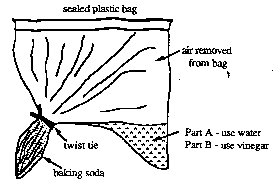Contributed by: New York State Education Department (NYSED)
NYS Alternative Assessment in Science Project (1996)
Task:
At this station, you will observe two types of interactions,
and then be asked to answer some questions about the interactions.
|
Materials:
- 2 resealable plastic bags
- 2 twist ties
- 1 half teaspoon measure
- 1 - 50 ml graduated cylinder
- baking soda
- vinegar
- water
- paper towels
- safety goggles
|
|
Background:
In nature many types of matter (chemicals) interact as they
come in contact with one another. With some chemical interactions
no change occurs, but with other chemical interactions, change
can occur.
Put on your safety goggles. Do not touch or taste any chemical.
Clean up spills immediately.
-
In one of the bags, put 1/2 teaspoon of baking
soda into one corner.
- Tie off the corner of the bag with a twist tie as shown in the
diagram.
- Measure 30ml of WATER and pour it into the empty corner.
- Remove as much air as possible and seal the bag tightly.
- Remove the twist tie from the bag and gently mix the baking
soda with the water.
- Describe what you observed after you mixed the contents of this
bag. List 2 observations.
7. Set the bag aside, and continue with Part B.
Part B
- In the other bag, put 1/2 teaspoon of baking soda into
one corner.
- Tie off the corner of the bag with a twist tie as shown in the
diagram.
- Measure 30 ml of VINEGAR and pour it into the empty corner.
- Remove as much air as possible and seal the bag tightly.
- Remove the twist tie from the bag and gently mix the baking
soda with the vinegar.
- Describe what you observed after you mixed the contents of this
bag! List two observations.
Questions:
1. In which of the bags did a chemical change occur? Circle your
answer.
|
The baking soda & water bag
|
The baking soda & vinegar bag
|
Both bags
|
Neither bag
|
2. Based on your knowledge of science and your observations, explain
why you think a chemical change occurred. Give 2 reasons to support
your answer.
3. Based on your knowledge of science and your observations, explain
why you think a chemical change occurred. Give 2 reasons to support
your answer.
|


